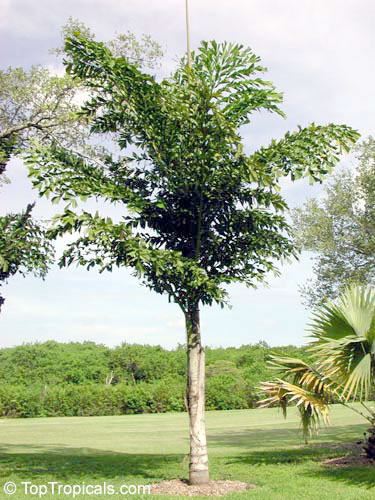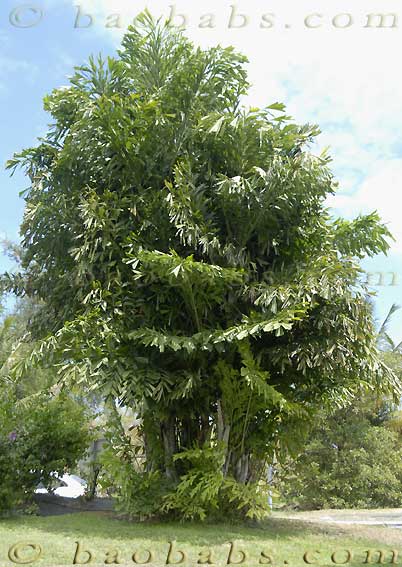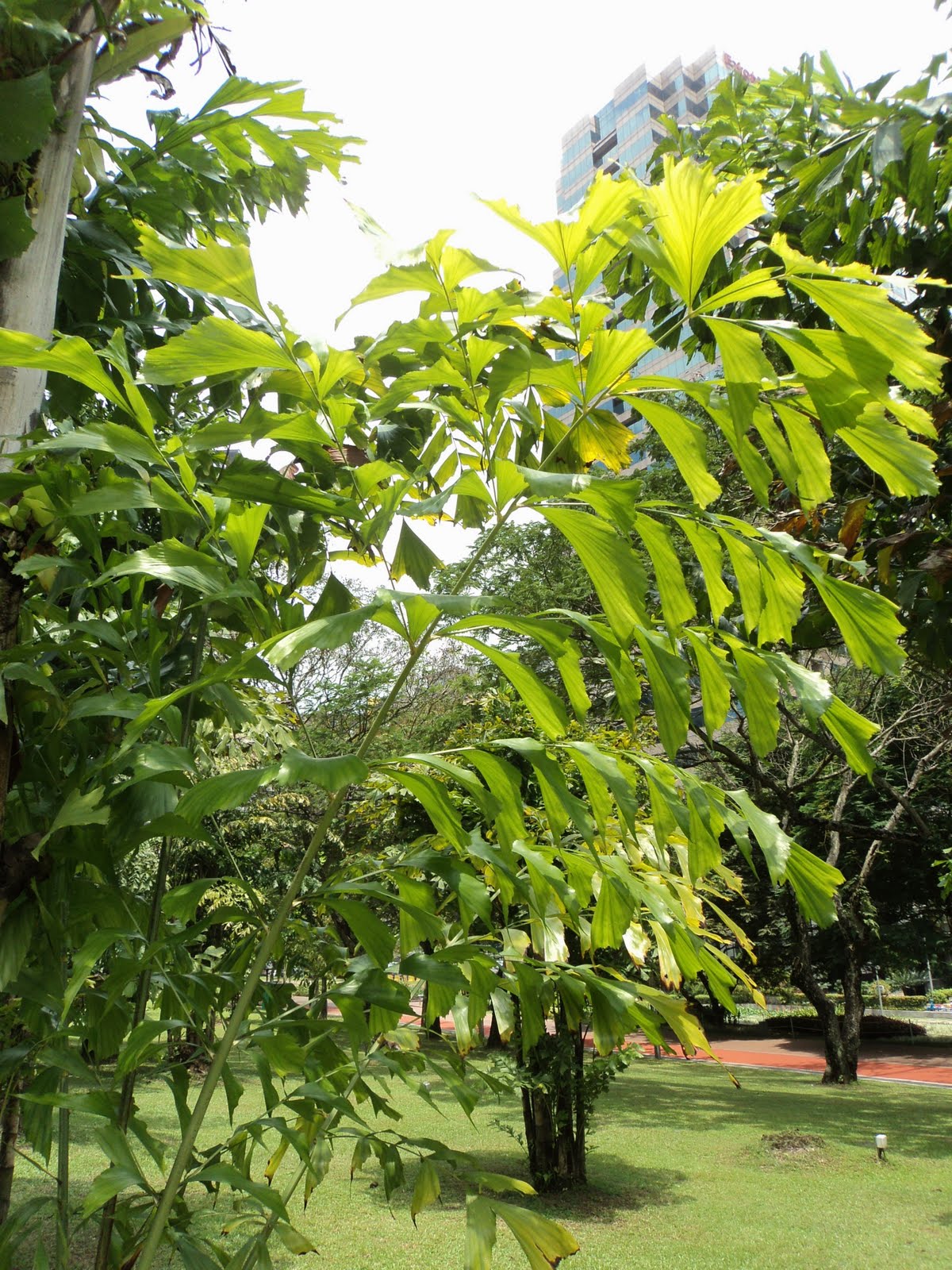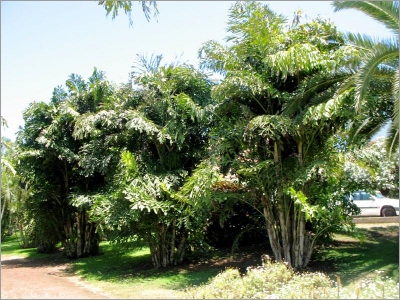Caryota
Caryota urens
The fish tail or burning palms ( Caryota ) (Size: tó Karyon = nut ) are a up in the South West Pacific native of South Asia palm genus. As the only palm genus it has twice pinnate leaves. The leaflets are fishtail shaped.
- 5.1 Notes and references
Features
The representatives are medium to large single or multi-stemmed palm trees. They are monoecious getrenntgeschlechtig ( monoecious ) and bloom and bear fruit only once ( hapaxanth ). The tribes have extended internodes, which are initially hidden by permanent fibrous leaf bases and sheaths. After some time, they are bald and are then covered with conspicuous annular, narrow leaf scars.
The chromosome number is 2n = 34
The leaves are bipinnate, only young plants are simply pinnate. Dead leaves remain on the stem ( Marzeszenz ) or fall off by its own weight. The leaf sheath is triangular, opposite the petiole it breaks up into strong black fibers, which are often existing ligule -like structure is also divided into black fibers. The surface of the leaf sheath is densely hairy and covered with chocolate brown scales.
The petiole is weak to very pronounced, furrowed on the upper side, rounded at the bottom. He wears a hair like the leaf sheath. The secondary blade spindles are regularly on the primary rachis. Rarely are lower in groups.
The leaflets are numerous and are quite regularly to the secondary blade spindles. They are wedge-shaped and have no distinct midrib, but several large vascular bundles emanating from the swollen, sometimes stalk -like base. The upper edges are strongly pulled. On the underside of leaves are broad bands of chocolate brown scales.
Inflorescences
The inflorescences are hermaphroditic, are individually and are formed in a basipetal order. They appear between the leaves, often they are under the crown of leaves. They are usually simple branches, rarely twice ( Caryota ophiopellis ), triple ( Caryota zebrina ) or they are ährig ( Caryota monostachya ).
The inflorescence stem is circular in cross-section, and densely covered with scales. The cover sheet is initially Roehrig, soon tearing up, zweikielig relatively small, densely hairy and / or scaly. The approximately eight bracts on the peduncle are striking, large and close to the flower as a bud one. They are leathery, initially Roehrig, tear irregularly and are usually densely hairy and / or scaly. The inflorescence axis can be shorter or longer than the peduncle. The flower-bearing lateral axes ( Rachillae ) are spirally arranged, are close together, are usually scaly. Each stands in the axil of a small, triangular high sheet. The base of the Rachilla is somewhat swollen, the lowest flower free portion is short to medium in length. The distal portion is more resistant to spiral away they occupied with proterandrischen flowers triads that are in inconspicuous Rachilla - bracts. The Brakteolen the flowers are flat and roundish.
Flowers
The male flowers are usually elongated and symmetrical. The three sepals are separate, leathery, roundish and are imbricat. The three petals are valvat, leathery and fused at the base. They are significantly longer than the calyx. There are 6 to about 100 stamens. Their filaments are short, sometimes fused at the base. The anthers are latrors, the connective can be extended to a point. A stamp rudiment is not formed. The pollen is ellipsoidal and more bisymmetrical. The germ is opening a distal sulcus. The longest axis measures 26 to 31 microns.
The female flowers are more spherical or oblong. The three sepals are leathery, roundish, imbricat and fused at the base. The three petals are leathery, valvat and grown Roehrig in the lower third to half. There are 0-6 staminodes present. The ovary is round or slightly triangular. He is one of three fruit compartments of which are fertile or two. At the base Septaldrüsen are available. The scar is three lobes and is apically. The ovules are hemianatrop and adaxial are attached to the base of the fruit compartment.
Fruit and seeds
The fruit is spherical and contains from one to two seed. The exocarp is smooth and dull colored, bright or dark to maturity. The mesocarp is fleshy and filled with many irritating needle-shaped crystals. A endocarp is not differentiated. The seeds are basal, are irregularly spherical or hemispherical, slightly furrowed or smooth. The endosperm is smooth or furrowed. The embryo is standing sideways.
Dissemination and locations
The distribution of the genus ranges from Sri Lanka, India and southern China to the south over Southeast Asia and Malaysia's to northern Australia, the Solomon Islands and Vanuatu. The climate ranges from monsoon climate to always moist areas. The representatives come from sea level prior to 2000 meters above sea level. They grow in primary forests and secondary forests, in the latter especially Caryota mitis.
System
The genus Caryota is placed in the subfamily Coryphoideae, Tribe Caryoteae within the family Arecaceae. The genus is monophyletic. Their sister group is the group of Wallichia and harangue.
In the World Checklist of Selected Plant Families of the Royal Botanic Gardens, Kew, the following types are recognized:
- Caryota albertii
- Caryota cumingii
- Caryota kiriwongensis
- Caryota maxima
- Caryota mitis
- Caryota monostachya
- Caryota no
- Caryota obtusa
- Caryota ophiopellis
- Caryota rumphiana
- Caryota sympetala
- Caryota urens
- Caryota zebrina
Use
All species are used. The shoot tips ( palm hearts ) are edible and tasty. Sago is obtained from the strains, wherein the larger species are preferred. The wood of Caryota urens is used as a timber. The fibers of the leaf sheaths are very durable and are processed into ropes about. The inflorescences, particularly Caryota urens of be tapped for the production of palm wine and sugar. Several species are grown as ornamental plants.
Documents
- John Dransfield, Natalie W. Uhl, Conny B. Asmussen, William J. Baker, Madeline M. Harley, Carl E. Lewis: Genera palmarum. The Evolution and Classification of Palms. Second edition, Royal Botanic Gardens, Kew 2008, ISBN 978-1-84246-182-2, pp. 297-300.









